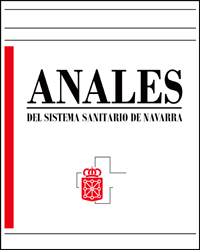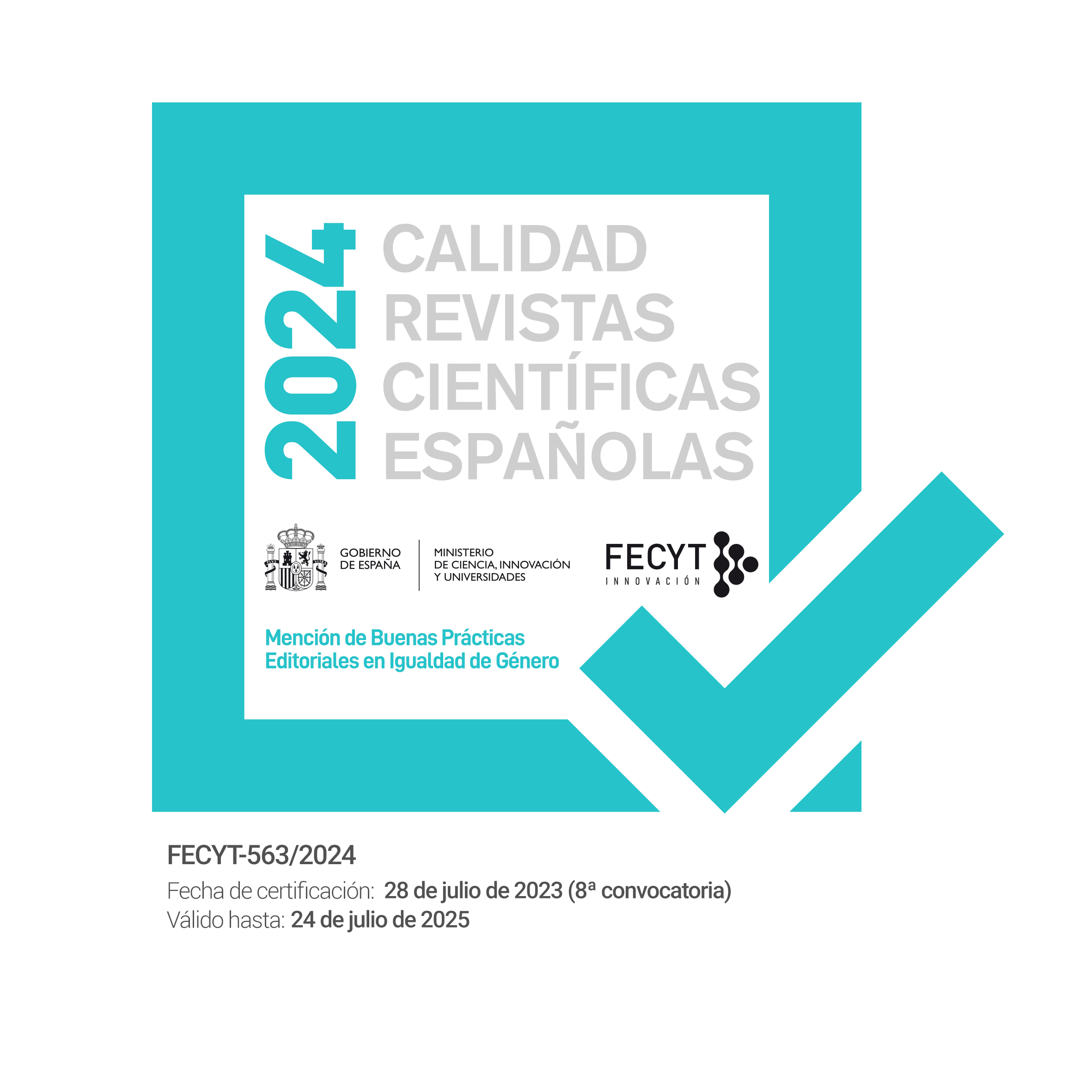Nivel de empoderamiento de las personas con insuficiencia cardíaca crónica hospitalizadas
##plugins.pubIds.doi.readerDisplayName##:
https://doi.org/10.23938/ASSN.0960Gako-hitzak:
Empoderamiento, Insuficiencia cardiaca crónica, Participación del pacienteLaburpena
Fundamento. Conocer el nivel de empoderamiento de las personas con insuficiencia cardiaca crónica hospitalizadas es crucial para identificar a las personas con un nivel de empoderamiento más bajo y fundamentar el diseño de estrategias efectivas para mejorar su control sobre las decisiones y acciones que afectan a su salud y bienestar. La falta de estudio de este fenómeno en esta población y contexto, sugiere que estos pacientes no están siendo atendidos adecuadamente.
Material y métodos. Estudio descriptivo, prospectivo. Se utilizó el Cuestionario de empoderamiento del paciente con enfermedad crónica, traducido y validado al español, que consta de 47 ítems, agrupados en tres dimensiones: Actitud positiva y sentido del control, Toma de decisiones compartida e informada, y Búsqueda de información y compartir entre iguales. Fue distribuido para su cumplimentación en las 24 horas previas al alta hospitalaria.
Resultados. Se recogieron 25 cuestionarios (81%). La puntuación global media de empoderamiento fue de 165,92 ± 20,9. La dimensión Actitud positiva y sentido de control fue la peor puntuada, con una media de 3,4 ± 0,5. Se encontró una relación inversa y débil entre el nivel de empoderamiento y la edad (rho = -0,240; p = 0,000) y una relación débil y positiva con la supervivencia a los 10 años (rho = 0,316; p = 0,01).
Conclusión. El nivel de empoderamiento de los pacientes de este estudio fue medio-alto. Las estrategias para abordar la atención de esta población deberían centrarse en trabajar su actitud respecto a la enfermedad y percepción de control de la situación e individualizarse conforme a la edad.
##plugins.generic.usageStats.downloads##
Erreferentziak
WHO 2014. Global status report on noncommunicable diseases. attaining the nine global noncommunicable diseases targets, a shared responsibility. https://apps.who.int/iris/bitstream/handle/10665/148114/9789241564854_eng.pdf;jsessionid=1542ACAED09875EE53387B1EA882F3AF?sequence=1
Instituto Nacional de Estadística. Defunciones según la causa de muerte. España 2017. https://www.ine.es/jaxi/Tabla.htm?path=/t15/p417/a2017/l0/&file=01000.px&L=0
GO AS, MOZAFFARIAN D, ROGER VL, BENJAMIN EJ, BERRY JD, BLAHA MJ et al. Executive summary: heart disease and stroke statistics 2014 update: a report from the American Heart Association. Circulation 2014; 129: 399-410, https://doi.org/10.1161/01.cir.0000442015.53336.12
SAYAGO-SILVA I, GARCÍA-LÓPEZ F, SEGOVIA-CUBERO J. Epidemiología de la insuficiencia cardiaca en España en los últimos 20 años. Rev Esp Cardiol 2013; 66: 649-656, https://doi.org/10.1016/j.recesp.2013.03.014
COWIE MR, ANKER SD, CLELAND JG, FELKER GM, FILIPPATOS G, JAARSMA T et al. Improving care for patients with acute heart failure: before, during and after hospitalization. ESC Heart Failure 2014; 1: 110-145, https://doi.org/10.1002/ehf2.12021
OLANO-LIZARRAGA M, OROVIOGOICOECHEA C, ERRASTI-IBARRONDO B, SARACÍBAR-RAZQUIN M. The personal experience of living with chronic heart failure: A qualitative meta-synthesis of the literature. J Clin Nurs 2016; 25: 2413-2429, https://doi.org/10.1111/jocn.13285
SEDLAR N, LAINSCAK M, MÅRTENSSON J, STRÖMBERG A, JAARSMA T, FARKAS J. Factors related to self-care behaviours in heart failure: A systematic review of European Heart Failure Self-Care Behaviour Scale studies. Eur J Cardiovasc Nurs 2017; 16: 272-282, https://doi.org/10.1177/1474515117691644
MCDONAGH TA, BLUE L, CLARK AL, DAHLSTRÖM U, EKMAN I, LAINSCAK M et al. European Society of Cardiology Heart Failure Association Standards for delivering heart failure care. Eur J Heart Fail 2011; 13: 235-241, https://doi.org/10.1093/eurjhf/hfq221
MYERS SL, SIEGEL EO, HYSON DA, BIDWELL JT. A qualitative study exploring the perceptions and motivations of patients with heart failure who transitioned from non-adherence to adherence. Heart & Lung 2020; 49: 817-823, https://doi.org/10.1016/j.hrtlng.2020.09.010
VAN DER WAL MJ, VAN VELDHUISEN DJ, VEEGER NJ, RUTTEN FH, JAARSMA T. Compliance with non-pharmacological recommendations and outcome in heart failure patients. Eur Heart J 2010; 31: 1486-1493, https://doi.org/10.1093/eurheartj/ehq091
JAANA M, SHERRARD H, PARÉ G. A prospective evaluation of telemonitoring use by seniors with chronic heart failure: Adoption, self-care, and empowerment. Health Informatics J 2019; 25: 1800-1814, https://doi.org/10.1177/1460458218799458
YU DSF, LI PWC, YUE SCS, WONG J, YAN B, TSANG KK et al. The effects and cost-effectiveness of an empowerment-based self-care programme in patients with chronic heart failure: A study protocol. J Adv Nurs 2019; 75: 3740-3748. https://doi.org/10.1111/jan.14162
THAKUR RD, FLEURY JD, SHEARER NBC, BELYEA M. Feasibility study of the health empowerment intervention in older adults with heart failure. J Cardiovasc Nurs 2020; 35: 538-544, https://doi.org/10.1097/JCN.0000000000000673
OMS. Salud mundial: retos actuales 2003. https://www.who.int/whr/2003/chapter1/es/index3.html
GARCIMARTÍN P, COMÍN-COLET J, PARDO-CLADELLAS Y, BADOSA N, LINAS A. Validation of the Spanish version of the questionnaire on Patient Empowerment in Long-Term Conditions. PLoS ONE 2020; 15: e0233338, https://doi.org/10.1371/journal.pone.0233338
GARCIMARTIN P, PARDO-CLADELLASD Y, VERDÚ-ROTELLAR JM, DELGADO-HITO P, ASTALS-VIZCAINOC M, COMIN-COLETB J. Adaptación transcultural al español del cuestionario Patient empowerment in long-term conditions. Aten Primaria 2019; 51: 24-31, https://doi.org/10.1016/j.aprim.2017.09.009
DELGADO JF, OLICA J, LLANO M, PASCUAL-FIGAL D, GRILLO JJ, COMÍN-COLET J et al. Costes sanitarios y no sanitarios de personas que padecen insuficiencia cardiaca crónica sintomática en España. Rev Esp Cardiol 2014; 67: 643-650. https://doi.org/10.1016/j.recesp.2013.12.016
CASTRO EM, VAN REGENMORTEL T, VANHAECHT K, SERMEUS W, VAN HECKE A. Patient empowerment, patient participation and patient-centeredness in hospital care: a concept analysis based on a literature review. Patient Educ Couns 2016; 99: 1923-1939. https://doi.org/10.1016/j.pec.2016.07.026
Declaration of Helsinki. Human experimentation code of ethics of the world medical association. Br Med J. 1964; 2: 177. https://doi.org/10.1136/bmj.2.5402.177
POLIT DF, BECK CT. Nursing Research. Principles and Methods. 8th ed. Philadelphia: Lippincott Williams & Wilkins, 2013.
CURRIE K, PATRICIA HS, SPALING M, HARKNESS K, BARBER D, CLARK AM. The importance of interactions between patients and healthcare professionals for heart failure self-care: A systematic review of qualitative research into patient perspectives. Eur J Cardiovasc Nurs 2015; 14: 525-35, https://doi.org/10.1177/1474515114547648
HEO S, LENNIE TA, PRESSLER SJ, DUNBAR SB, CHUNG ML, MOSER DK. Factors associated with perceived control and the relationship to quality of life in patients with heart failure. Eur J Cardiovasc Nurs 2015; 14: 137-144. https://doi.org/10.1177/1474515113519931
BANERJEE T, LEE KS, BROWNING SR, HOPENHAYN C, WESTNEAT S, BIDDLE MJ et al. Limited Association between perceived control and health- related quality of life in patients with heart failure. J. Cardiovasc Nurs 2014; 29: 227-231. https://doi.org/10.1097/JCN.0b013e31828b2b23
DRACUP K, WESTLAKE C, ERICKSON VS, MOSER DK, CALDWELL ML, HAMILTON MA. Perceived control reduces emotional stress in patients with heart failure. J. Heart Lung Transplant 2003; 22: 90-93. https://doi.org/10.1016/s1053-2498(02)00454-0
LIN CY, MILLER JL, LENNIE TA, BIDDLE MJ, MUDD-MARTIN G, HAMMASH M et al. perceived control predicts symptom status in patients with heart failure. J Cardiovasc Nurs 2020; 35: 530-537, https://doi.org/10.1097/JCN.0000000000000684
BARR PJ, SCHOLL I, BRAVO P, FABER MJ, ELWYN G, MCALLISTER M. Assessment of patient empowerment--a systematic review of measures. PLoS ONE 2015; 10: e0126553. https://doi.org/10.1371/journal.pone.0126553
WHO: World Health Organization 2020. WHOQOL: Measuring Quality of Life. https://www.who.int/healthinfo/survey/whoqol-qualityoflife/en/
KÖHLER AK, TINGSTRÖM P, JAARSMA T, NILSSON S. Patient empowerment and general self-efficacy in patients with coronary heart disease: a cross-sectional study. BMC Fam Pract 2018; 19: 76, https://doi.org/10.1186/s12875-018-0749-y
FAULKNER M. A measure of patient empowerment in hospital environments catering for older people. J Adv Nurs 2001; 34: 676-686, https://doi.org/10.1046/j.1365-2648.2001.01797.x
SMALL N, BOWER P, CHEW-GRAHAM CA, WHALLEY D, PROTHEROE J. Patient empowerment in long-term conditions: development and preliminary testing of a new measure. BMC Health Serv Res 2013; 13: 263. https://doi.org/10.1186/1472-6963-13-263
FITZSIMONS D, STRACHAN PH. Overcoming the challenges of conducting research with people who have advanced heart failure and palliative care needs. Eur J Cardiovasc Nurs 2012; 11: 248-254. https://doi.org/10.1016/j.ejcnurse.2010.12.002
PÉREZ-PALOMA P, GONZÁLEZ-URMENETA I, RODA-CASADO C, VÁZQUEZ-CALATAYUD M. Una revisión sistemática de las intervenciones para empoderar al paciente con insuficiencia cardiaca crónica en el entorno hospitalario. An Sist Sanit Navar 2020; 43: 393-403 . https://doi.org/10.23938/ASSN.0925
Ministerio de Sanidad, Servicios Sociales e Igualdad. Gobierno de España. Estrategia para el abordaje de la cronicidad en el Sistema Nacional de Salud. Madrid: MSSSI, 2020 https://www.mscbs.gob.es/organizacion/sns/planCalidadSNS/pdf/ESTRATEGIA_ABORDAJE_CRONICIDAD.pdf
##submission.downloads##
Argitaratuta
##submission.howToCite##
Zenbakia
Atala
##submission.license##
##submission.copyrightStatement##
##submission.license.cc.by-sa4.footer##La revista Anales del Sistema Sanitario de Navarra es publicada por el Departamento de Salud del Gobierno de Navarra (España), quien conserva los derechos patrimoniales (copyright ) sobre el artículo publicado y favorece y permite la difusión del mismo bajo licencia Creative Commons Reconocimiento-CompartirIgual 4.0 Internacional (CC BY-SA 4.0). Esta licencia permite copiar, usar, difundir, transmitir y exponer públicamente el artículo, siempre que siempre que se cite la autoría y la publicación inicial en Anales del Sistema Sanitario de Navarra, y se distinga la existencia de esta licencia de uso.








